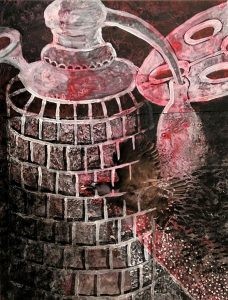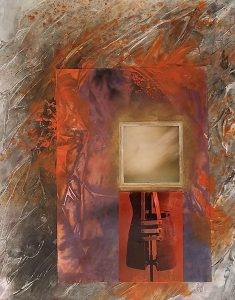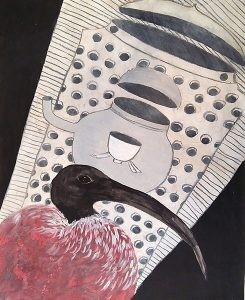Carol Brown
Curator, former DAG director, ArtSpace, 20 July 2015
THE TITLE of this series is drawn from a poem by T S Eliot, who, in his Four Quartets, wrote: ‘ … at the still point, there the dance is …’
This is a complex idea; it can simply be interpreted as the instant where something enlightening suddenly arrives, and provokes a new way of looking or feeling. It seems necessary to have those moments of stillness as well as of a metaphorical explosion or release of energy.

Alembic 2 – acrylic, guache, pastel, charcoal, ink on paper
The collection includes three images of an alembic, the term for an alchemic still. I am not sure if the play on words between this term and the series title is intentional, but if not, it surely is happenstance, which imbues much of what happens in this body of work. In viewing these works, we should keep both meanings in mind, while also remaining conscious of Eliot’s reference to the ‘dance’.
The palette is a restricted one, mainly comprising the elemental colours black, red and white. They are used in alchemy, but also have other powerful connotations, notably fear, blood, passion, purity, darkness and light. The emotive power of this palette is initially what attracts us to and involves us in the work.
Initially, we are drawn to the movement of the spirals that are a recurring theme. A spiral is an archetypal symbol of flowing and continual renewal and, in Jungian terms, of cosmic force. But a closer look reveals clues to deeper meanings. This reminds us that everything that happens to us is an accumulation of our personal history, both physical and psychological, and art is made from this body of experience.

Breathing – acrylic, guache, pastel, ink on paper
In ‘Breathing’, and several other images, see an orthopaedic brace. This relates to the artist’s teenage years when, for 18 months, she had to wear a brace to counteract scoliosis. It is well known that our bodily experiences influence our minds, and we see evidence of this in the constant interplay between control and freedom: control in the formality of the geometric shapes; freedom, in gestures that are both random and free-flowing, in the way that consciousness can be. The dots that surface continuously can symbolise many things, including an unravelling (as in the work of the Japanese artist Yayoi Kusama), or the perfect existence of colour (as Damien Hirst’s spot paintings).
But abstraction and pattern are only part of the work. Embedded in these structures we find a personal language of images. Among the most pervasive are the fragmented images of birds.

Ibis – acrylic, guache, pastel, charcoal, ink on paper
Birds, with their fragile feathers and wings, suggest flight and freedom. But they can also refer to entrapment – an entrapment which we, as humans, have imposed upon them in keeping them in cages, or hunting and killing them. Is the artist leading us to consider freedom and escape, or is she asking us to recognise the similarities between human and other beings? This challenges the viewer.
The artist’s repeated representation of birds as well as fish reminds us of the presence of territories that we do not normally inhabit – we, as humans, populate the surface of the earth; the zones above and below remain relatively uncharted ones that are still mysterious, sometimes threatening, and sometimes transformative. We are reminded that there are worlds and experiences outside of the mundane.
This series is the result of many years of exploration by an artist who has studied fine art, philosophy, and languages, and has a strong interest in what she describes as ‘the invisible thresholds which we consciously and unconsciously cross all the time’. It is a thought-provoking collection, with many layers and challenges.